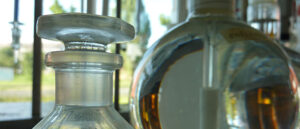Our wet chemical laboratory works with a broad spectrum of various methods making the analysis of glass’ important characteristics possible. That is why we are among others capable of identifying the exact composition of glass or parameters appropriate to pharmaceutic standards. In the following structure for each subitem some methods and possibilities are presented. However, they do not depict our full range in this field. Please contact us via the contact formula or call us if you want to find out, weather we can offer a helpful product. We have accreditation for methods marked with an asterisk *.
Glass Composition
LIBS – Laser-induced breakdown spectroscopy*
Application as an in-house procedure
Concentration of silicic acid (gravimetric)*
DIN 52 340-2 “Chemical analysis of colourless soda-lime-glass with SiO2, CaO, MgO and Na2O as main constituents; determination of SiO2”
Flame photometric determination of Na, K and Li
DIN 52 340-8 “Chemical analysis of colourless soda-lime-glass – determination of Na2O and K2O by flame atomic emission spectroscopy (AES)” (Additional determination of lithium)
Determination of boron (titrimetric/flame photometric)*
DIN EN ISO 21 078-1 “Determination of boron(III) oxide in refractory products – Part 1: Determination of total boron (III) oxide in oxidic materials for ceramics, glass and glazes”
DIN 51086-2 & -3 Testing of oxidic raw materials and materials for ceramics, glass and glazes
Analysis using in-house methods (cold HF stirred digestion)

Determination of fluoride content after pyrohydrolysis
DIN 51 084 “Testing of oxidic raw and basic materials for ceramic, glass and glazes – determination of fluoride content”
Mercury determination with ICP hydride system*
DIN 51086-2 Testing of oxide raw materials and materials for ceramics, glass and glazes
ICP-OES* (f. ex. Alkalies, alkaline earth metals, heavy metals, assay of traces,…)
DIN 51086-2 Testing of oxidic raw and basic materials for ceramic, glass and glazes – Part 2: Determination of Ag, As, B, Ba, Be, Bi, Ca, Cd, Ce, Co, Cr, Cu, Er, Eu, Fe, La, Mg, Mn, Mo, Nd, Ni, P, Pb, Pr, S, Sb, Se, Sn, Sr, Ti, V, W, Y, Yb, Zn, Zr by inductively coupled plasma optical emission spectrometry (ICP OES)
DIN EN ISO 11885 Water quality with ICP-OES
Photometric chromium(VI) determination
DIN 51086-3 Testing of oxidic raw materials and materials for ceramics, glass and glazes – Part 3: Spectrophotometric determination of chromium(VI) with diphenylcarbazide in the presence of chromium(III)
Titrimetric determination of CO2, Chlorid, Na2O und B2O
Application as an in-house procedure
Determination of iron(III) oxide and iron(II) oxide
Application as an in-house procedure
X-ray fluorescence analysis – XRF*
DIN 51001 “Testing of oxidic raw materials and basic materials – general bases of work for X-Ray fluorescence method (XRF)” (together with supplement 1)
µRFA – Application as an in-house procedure
X-Ray phases analysis – XRD*
DIN EN 13925-Part 1 and 2 “Non-destructive testing – X-ray diffraction from polycrystalline and amorphous material
– Part 1 and 2”
Resistances
Hydrolytic resistance at 98 °C* (glass grains method)
DIN ISO 719 “Hydrolytic resistance of glass grains at 98 °C; Method of test and classification”
Japanese Pharmacopoeia – 7.01 „Test for Glass Containers for Injections – Method 1“
Hydrolytic resistance at 121 °C* (glass grains method)
DIN ISO 720 “Hydrolytic resistance of glass grains at 121 °C, Method of test and classification”
European Pharmacopoeia – 3.2.1 „Glass Containers for pharmaceutical use – Test B“
United States Pharmacopoeia – <660> „Containers-Glass – Glass Grains Test“
Hydrolytic resistance of inner surfaces at 121 °C incl. concentration of arsenic*
DIN ISO 4802-1 „Glassware – Water resistance of the inner surface of glass containers – Part 1: Determination by the titration method and classification“
DIN ISO 4802-2 „Glassware – Water resistance of the inner surface of glass containers – Part 2: Determination by flame spectrometry and classification“
European Pharmacopoeia – 3.2.1 „Glass Containers for pharmaceutical use – Test A, Test C und Arsen“
United States Pharmacopoeia – <660> „Containers-Glass – Surface Glass Test“
Japanes Pharmacopoeia – 7.01 „Test for Glass Containers for Injections – Method 2“
Chemical resistance (acid class and base class)
DIN 12116 „Resistance to a boiling aqueous hydrochloric acid solution – Test method and classification“
DIN ISO 1776 “Glass; Resistance to attack by hydrochloric acid at 100°C; Flame emission or flame atomic absorption spectrometric method”
DIN ISO 695 “Resistance to attack by a boiling aqueous solution of mixed alkali; Method of test and classification”
Lead and cadmium discharge from consumer goods made of glass
DIN EN 1388-2 „Determination of the release of lead and cadmium from silicate surfaces“

